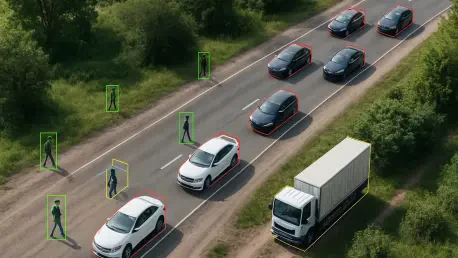In an era where unmanned aerial vehicles (UAVs) are becoming indispensable tools for tasks like disaster response, urban planning, and environmental monitoring, the challenge of achieving accurate object detection under tight computational constraints remains a significant hurdle. These devices often operate in remote or critical environments where real-time data processing is vital, yet their limited onboard resources make deploying heavy deep learning models impractical. A groundbreaking solution has emerged from a research team at Osaka Metropolitan University, introducing a framework that promises to redefine efficiency in UAV-based remote sensing. This innovative approach tackles the dual need for high precision and lightweight design, ensuring that even resource-constrained devices can perform complex detection tasks effectively. By addressing the unique challenges of aerial imagery, such as varying object sizes and lighting conditions, this development marks a notable advancement in the field, setting the stage for broader practical applications.
Revolutionizing UAV Detection with Innovative Design
A key issue in UAV object detection has long been the trade-off between accuracy and computational efficiency, as traditional deep learning models often require substantial processing power that exceeds the capabilities of most aerial devices. The research team, led by graduate student Hoang Viet Anh Le and Associate Professor Tran Thi Hong, has introduced a novel framework called SORA-DET (Shallow-level Optimized Reparameterization Architecture Detector). This model is specifically engineered for remote sensing tasks, prioritizing a lightweight structure without sacrificing performance. By focusing on streamlined algorithms, SORA-DET ensures that UAVs can process data in real time, which is crucial for time-sensitive operations like search-and-rescue missions. The framework’s design reflects a deep understanding of the practical limitations faced by UAVs, offering a solution that aligns with the growing demand for compact yet powerful detection systems in diverse fields.
Central to SORA-DET’s success are two pioneering components that enhance its functionality while keeping resource demands minimal. The Partial Reparameterization Convolution Block (PRepConvBlock) simplifies convolution processes, enabling the use of larger kernels to capture broader feature interactions without imposing a heavy computational load. Additionally, the Shallow Bi-directional Feature Pyramid Network (SB-FPN) integrates information across different feature levels, improving the detection of objects that vary widely in size and complexity within aerial imagery. Together, these elements allow SORA-DET to operate with up to four detection heads, striking an impressive balance between speed and precision. This architecture not only addresses hardware constraints but also enhances the visual representation of data, making it a versatile tool for UAV applications where adaptability to challenging conditions is essential.
Benchmark Performance and Real-World Impact
When put to the test, SORA-DET demonstrates remarkable efficiency, setting itself apart from many larger-scale models that dominate the field of object detection. Benchmark results reveal a mean Average Precision (mAP50) of 39.3% on the VisDrone2019 dataset and an impressive 84.0% on the SeaDroneSeeV2 validation set, showcasing its ability to handle diverse detection challenges. What makes these figures even more striking is that SORA-DET achieves this performance with 88.1% fewer parameters than comparable models, alongside an inference speed of just 5.4 milliseconds. Such metrics highlight its suitability for real-time applications on lightweight devices, where every millisecond counts. This level of optimization ensures that UAVs equipped with SORA-DET can deliver accurate results without being bogged down by excessive computational demands, paving the way for more accessible and efficient aerial monitoring solutions.
Beyond raw performance data, the practical implications of SORA-DET are profound, particularly in scenarios where rapid and reliable object detection can save lives or protect resources. Fields such as disaster management benefit immensely from a framework that allows UAVs to quickly identify critical elements in chaotic environments, whether it’s locating survivors or assessing structural damage. Similarly, environmental monitoring tasks, such as tracking wildlife or detecting illegal activities, gain from the model’s ability to process complex imagery on the fly. By reducing the barrier to entry for advanced detection capabilities, SORA-DET enables a wider range of organizations to leverage UAV technology, even in regions with limited access to high-end hardware. This democratization of technology underscores the framework’s potential to transform how aerial data is utilized across various industries, fostering innovation in operational strategies.
Future Horizons in UAV Technology
Looking ahead, the development of SORA-DET signals a shift toward more adaptable and efficient models that can meet the evolving needs of UAV applications over the coming years. As remote sensing continues to play a critical role in addressing global challenges, from climate change to urban expansion, the demand for solutions that balance performance with practicality will only grow. SORA-DET’s lightweight architecture offers a blueprint for future innovations, encouraging the design of systems that can operate effectively on edge devices without requiring constant upgrades to hardware. This focus on efficiency could inspire further research into optimizing other aspects of UAV functionality, such as energy consumption and data transmission, ensuring that these tools remain viable for long-term deployment in diverse settings.
Reflecting on the strides made with SORA-DET, it’s evident that the efforts of the Osaka Metropolitan University team have laid a strong foundation for enhancing UAV capabilities in critical areas. The successful integration of high accuracy and rapid processing in a compact framework addresses persistent challenges that once hindered real-world applications. Moving forward, stakeholders in remote sensing and artificial intelligence should consider building on this progress by exploring collaborative initiatives to refine such technologies. Adapting SORA-DET for specialized use cases or integrating it with emerging tools could amplify its impact, ensuring that UAVs remain at the forefront of solving pressing societal issues with unmatched precision and efficiency.









